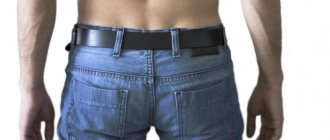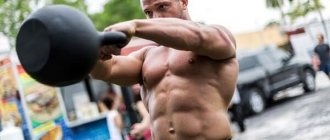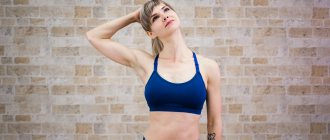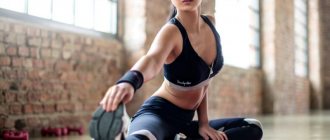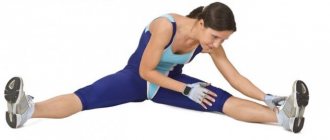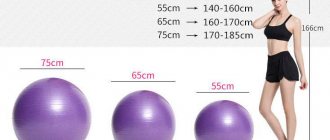Effective exercises to keep the body in good shape in some cases involve the use of additional sports equipment. If in the gym, a woman has the opportunity to work out with all the equipment presented in the establishment, then at home it will be difficult to significantly transform herself with the help of available weights.
To effectively get rid of fat, as well as increase muscle relief, fitness trainers recommend using a fitball in home exercises.
How to choose the right ball
Exercises with a fitball for the whole body, provided they are performed regularly, will bring visible results to a woman, provided that the ball used in training is chosen correctly.
A fitball (or “Swiss ball”) is a large rubber ball with increased strength and elasticity. It is actively used by professional athletes in preparation for competitions and by fitness trainers to qualitatively transform the body of their clients.
With its help, in most cases it is possible to:
- use all muscle groups of the athlete’s body, while avoiding negative effects on the joints and cardiovascular system;
- increase a person’s dexterity, coordination and flexibility, regardless of his age;
- correct posture;
- carry out the prevention of diseases of the joints and skeletal system associated with the thinning of cartilage tissue;
- lose excess weight in the shortest possible time without putting the body into a state of stress;
- keep your figure in shape by regularly performing a basic set of exercises that do not require a lot of time and physical investment.
To choose the right tool for training, a woman should decide what type of fitball she needs in specific circumstances.
There are 4 types of balls:
- With “horns” that allow you to maintain balance. Recommended for sports activities for children and beginner athletes with low physical fitness.
- With spikes" . Recommended for use by people planning to lose excess weight through fitball exercises. Rubber protrusions – “spikes” – serve as an additional stimulation of blood circulation, which directly affects the condition of human skin.
- Smooth . Can be used by people of all ages. Most often, this type of fitball is recommended for pregnant women. With the help of a ball, expectant mothers can not only maintain the elasticity of ligaments and muscles, but also ease contractions at the time of the onset of labor at home.
- Children's. A fitball of minimal size, used to strengthen the muscles of infants.
A properly selected fitball must meet the characteristics of high-quality sports equipment:
- The ball should be selected according to the girl’s height. Recommended ratio: height less than 155 cm - ball 45 cm in diameter; height 155 – 169 cm – the ball is no more than 55 cm in diameter; 69 – 185 cm – diameter – 65 cm; more than 186 cm – diameter more than 75 cm).
- When there is a mechanical impact on the ball, for example, pressing on it with the palm of your hand, the rubber projectile should spring back.
- The fitball must withstand the maximum weight specified by its manufacturer without being unduly deformed.
- The seams on the ball should be invisible.
- No static effect.
- Maximum depression of the nipple into the ball.
What should a fitball be like?
This projectile is most effective when the size is chosen correctly. Gymnastic balls are produced in three diameter variations:
- small 55 cm;
- average 65 cm;
- large 75 cm.
The first are intended for people whose height is 149-164, the second - 164-171, and the third - 180 centimeters and above.
To properly pick up a Swiss ball, you need to sit on top of it. If the hips and knees form a right angle with respect to the floor surface, then the projectile is ideal in size.
Tips for training with a fitball
Exercises with a fitball for the whole body require strict adherence to the technique of their implementation. Otherwise, the type of load in question will not only have minimal effectiveness, but may also cause the athlete to suffer an injury or sprain.
To avoid this, it is important to follow the basic recommendations for training with a fitball:
- Before and after class, devote the proper amount of time to warm-up and cool-down , respectively. This approach to organizing training will allow a girl, regardless of the level of the chosen load, to minimize muscle pain after working them out on the ball.
- When performing exercises, focus on quality rather than speed, trying to feel the muscles working as much as possible under any type of load.
- Perform exercises to work all muscle groups , not just the problem area. Ignoring this recommendation can lead to overtraining, as well as significantly worsen the overall appearance of the athlete.
- Adjust the density of the fitball inflation depending on the girl’s physical fitness. The more the ball is inflated, the higher the level of difficulty of performing exercises on it. During the first exercises, it is recommended to slightly deflate the sports equipment, thus allowing the body to gradually get used to physical activity.
- To achieve the desired result in the shortest possible time, it is recommended to contact a fitness trainer who is able to properly organize the training process, taking into account the client’s health condition, her goal and level of physical fitness. If it is not possible to use the services of a professional, it is recommended to build your classes on the principle of circuit training.
- Perform exercises that do not cause pain or significant discomfort. For example, people with poor vestibular apparatus should initially avoid exercises that involve rolling on a ball or face-down rotational movements.
- If it is necessary to increase the load , it is not recommended to perform more repetitions than the training program provides. In such circumstances, fitness trainers recommend modifying the load by artificially creating the need to use weights, such as dumbbells.
When exercising with a fitball, as with other types of physical activity, it is recommended to pay attention to your well-being during the first workouts, as well as after increasing the load.
A slight malaise or a more acute reaction of the body to sports should be a reason to contact a doctor for an additional examination.
Other therapeutic exercises
In addition to physical therapy, the following are used to treat spinal hernia:
- Bubnovsky method;
- exercises according to Dikul;
- water gymnastics;
- yoga and pilates.
Each of these methods has its own characteristics. Before you start performing them, find out their differences from conventional physical therapy, the benefits and harms of a hernia, when you can do it or not.
According to the Bubnovsky method
Dr. Sergei Bubnovsky wrote about back hernia in the book “Spinal hernia is not a death sentence.” He developed most of the exercises taking into account the simulators that are available in his clinic.
Opinions about the method are mixed. There are many cases that after treatment in his clinics hernia:
- not only did it not decrease, but increased, it was even necessary to resort to surgery;
- the pain disappeared in one place, appeared in another, requiring hospital treatment and even surgical intervention.
The main reasons for failure are rigid, heavy exercises, which are strictly prohibited in case of a spinal hernia (strength loads, twisting).
If you still decide to try gymnastics using this method, avoid training that is prohibited if you have a back hernia. It is better to do the complex for prevention, when the acute phase has passed, there is no pain.
According to Dikul
Exercises suggested by Valentin Dikul, director of a rehabilitation center for patients with back injuries, have a good effect on the spine. You can learn about his method in his book “Treating the back from hernias and protrusions.” He offers different types of training, including standard therapeutic exercises that can be performed for spinal hernia (half-cobra, cat).
The complex that Dikul offers consists of several stages:
- Exercises aimed at eliminating pain. They are performed with a small amplitude, without additional load. Basic movements are a standard exercise therapy complex. Course – 3 times a week for 2-4 months.
- Exercises aimed at strengthening muscles are a rehabilitation period when the pain has gone away. At this stage, you can include strength training. Course – 4 times a week for 2-3 years.
- Complete workouts designed taking into account the presence of a hernia, without negative effects on the affected area.
Exercises must be performed in strict sequence, do not change places, and do not increase the number of repetitions. The load (light dumbbells) can be taken no earlier than the complex is mastered and the pain disappears. Between exercises you need to rest for 2-3 minutes.
Exercises in water
Swimming gives good results in the treatment of spinal hernias. Water relieves stress from the back and calms the nervous system. It helps to better stretch the space between the discs and reduce the pressure of the hernia on the nerve fibers. The main thing is to choose the right instructor and exercises.
The following activities have a good effect:
- The face is lowered into the water, the arms are extended, holding a swimming board (you can use a crossbar installed around the perimeter of the pool), the back is straight. The legs swim in the crawl style.
- Lie on your side, your right hand rests on the board, your left along your torso. The legs work in the crawl style.
- Swim on your back. Hands hold the board on your stomach, legs swim in crawl style.
If the pool is shallow (water up to your chest), you can take steps in place with your knees raised high. At this time, the arms move as if running. Gentle turns of the body to the right and left have a good effect.
The only contraindication for water exercises is the acute phase of pain. Jumping into the water is strictly prohibited. You can't swim with your head held high. The breaststroke and butterfly styles are undesirable.
Yoga and Pilates for hernia
Yoga and Pilates are based on slow loads without overexertion. They improve the condition of muscles, tendons, and stretching. But with a herniated disc, many exercises are prohibited (bridges, twisting, strong stretches). Moreover, they cannot be done during an exacerbation period.
When giving preference to these methods, pay attention to exercises that are designed specifically for spinal hernia. The basic complex is not much different from exercise therapy - cobra, cat, bird-dog.
During the period of pain, avoid any strength or other prohibited exercises. If pain occurs, stop exercising. Additional equipment that is often used in Pilates (dumbbells, other weights) can be taken only at the stage of remission, when the pain has gone.
Lower body exercises
Exercises with a fitball for the whole body are best structured so that at the beginning of the workout the main load goes to the lower part (legs, hips, buttocks). Considering the direction of lymph flow in the body, this method of organizing the lesson will allow the body to enter the training process as naturally as possible.
| Exercise with fitball | Technique for its implementation |
| Squats with arm raises |
|
| Wall Squats |
|
| Squats with a fitball clamped with knees |
|
| Gluteal bridge |
|
| Lunges |
|
For slimming thighs
The fitball helps to engage almost all muscle groups in the legs if you perform the appropriate exercises. The result is weight loss in the thighs and the absence of cellulite.
Static squat
- Stand against the wall. Place the fitball between your back and the surface of the wall.
- Squat so that your thighs are parallel to the floor. The back is straight.
- Hold the squat as long as possible.
Leg raise
- Lie on your back, with your outstretched feet resting on an inflatable ball.
- Alternately raise your left and right legs without lifting your torso from the floor.
- There is an inverted version of the exercise.
Swing to the side
- Face down, legs straight on the ball.
- Take your legs to the side one at a time and lower them down, touching the floor.
Upper body exercises
Exercises with a fitball for the whole body should equally involve both legs and arms. Upper muscle groups usually require more time to transform, so performing at least 2-3 arm exercises in each workout is a prerequisite for effective training.
| Exercise with fitball | Technique for its implementation |
| Fitball push-ups |
When performing this exercise, it is important to ensure that the abdominal muscles do not relax from the moment the load begins until it is completed. |
| Plank diagonally |
|
| Rolling the fitball forward |
|
| Reverse ball push-ups |
|
| Static bar |
|
Lose weight in the abdominal area: what exercises are effective
It is important to understand: everyone has abdominal muscles, but for most they are hidden by a layer of fat. It is this that creates excess volume and does not allow you to create a beautiful relief. Therefore, the basis of training should be both strength exercises (which strengthen muscles) and cardio exercises (which reduce the thickness of the fat layer). “You can divide these loads and, for example, do cardio and do strength exercises on different days,” explains Valentin Zinin, instructor of SuperPopa group programs at Kometa.fit clubs .
What aerobic workouts are effective? Running, vigorous walking, Nordic walking, cycling, swimming. It is optimal to do them for 40-60 minutes 3-5 times a week - this way the body quickly switches to fat burning mode.
Which abdominal exercises to choose? These are all variants of body twists, strips and “folds”. “I recommend using a fitball in abdominal training,” adds Valentin Zinin. “It helps recruit additional muscle groups, plus it increases the load, since in this case we are working on an unstable basis.”
And, of course, fitball brings some variety to your workouts.
We asked Valentin Zinin to compose and show us a set of exercises on a fitball that helps strengthen the abdominal muscles.
Back and arm workout
Exercises with a fitball, aimed at working out the whole body, help not only transform a girl’s figure, but also improve her health, for example, by strengthening the back muscles that support the spinal column.
If you have spinal diseases, before performing this complex, it is recommended to consult a doctor to determine whether there is a need to adjust the loads.
| Exercise with fitball | Technique for its implementation |
| Reverse boat |
|
| Hyperextension |
|
| Bridge |
During the exercise, sudden movements are not allowed. “Bridge” is not recommended for people with a low level of physical fitness and dysfunction of the vestibular apparatus. |
| Leg raises lying on a fitball |
This exercise requires great muscle strength, as well as ideal condition of the vestibular apparatus. It is recommended to perform it at the beginning of a block of exercises to strengthen the back and arms. |
general information
A fitball is a gymnastic ball ranging in size from 55 to 80 cm, in other words, it is a fitness and aerobics ball.
The classes are quite energy-intensive and effective. They immediately “kill two birds with one stone” - they remove extra pounds and strengthen the musculoskeletal system.
Most of the exercises are universal: simultaneously working the same muscles (for example, the pectoral muscles and triceps), as well as opposing muscles (the muscles of the lower back and the abdominal muscles).
In addition, the exercises are aimed at developing the vestibular apparatus and coordination of movements, which helps train deep (skeletal) muscles and stabilizer muscles. This is due to the constant need to maintain balance or shift the overall center of gravity of the body. No other well-known simulator can boast of this feature.
Fitball classes can be done at home, working out individually, or in special fitness centers, working out in groups, where work with this equipment will be supervised by an instructor. The range of exercises and their effects is so wide that in one lesson lasting 1 - 1.5 hours, it will be impossible to try them all.
In addition, daily 20-minute exercises will help you stay in shape and correct your figure without particularly straining.
Exercises on a fitball for the back and abs
An integral part of any set of physical exercises should be working out the abdominal area. The abdominal muscles, being in good shape, maintain normal blood circulation in the area of the woman’s pelvic organs, which ensures good health of the genitourinary system.
| Exercise with fitball | Technique for its implementation |
| Lifting the body at an angle |
|
| Transferring a fitball between limbs |
|
| Leg raises while lying on the floor |
|
| Body turns |
|
Any type of fitball helps not only improve the appearance of the athlete’s entire body, but also improve her health, and also minimize the risk of premature aging of the female body. Regular exercise of this type trains muscles, improves blood circulation, providing vital systems with sufficient oxygen.
This video contains one of the most effective sets of exercises for beginners:
With the correct preparation of the complex, as well as following the technique of conducting training with a fitness ball, a woman will notice the first positive changes in her condition after 1-2 months of regular training.
Is it possible to exercise on a ball in the 2nd and 3rd trimesters?
Balloon classes are available to expectant mothers from the very beginning of pregnancy. This sport is absolutely harmless to their body and fetus. If a woman did not exercise on a ball in the first months of pregnancy, you can start exercising in the 2nd trimester. Classes are also shown in the 3rd trimester. It is worth remembering that the process must take place under the close supervision of a trainer.
In the 2nd trimester, the rates that were used at the beginning of pregnancy are acceptable. This is a period when you can stretch, train muscles, and form beautiful posture. In the 3rd trimester, the pace must be reduced. Before giving birth, sudden movements and increased stress are contraindicated for a woman. Relatively quiet exercises to work the intimate and pelvic muscles are recommended.

